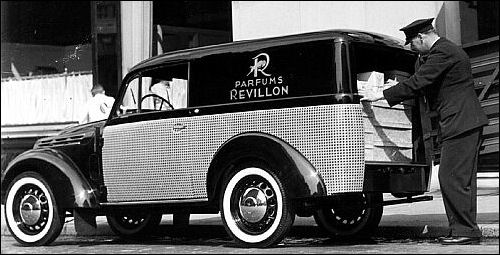
Publication October '38.

Renault eksportuje swoje samochody do Ameryki Południowej.

Publication October '38.

Renault eksportuje swoje samochody do Ameryki Południowej.
Oferta Renault na rok 1939 wygląda podobnie jak w roku ubiegłym; składa się z trzech grup modeli 4-, 6- i 8-cylindrowych. Wszystkie one otrzymały drobne retusze w postaci poziomo żebrowanych krat wlotu powietrza. Silniki z aluminiowymi głowicam są lżejsze, cichsze i bardziej oszczędne. Wspomaganie hamulców instalowany jest we wszystkich modelach z wyjątkiem Novaquatre. Niestety Renault wciąż nie ma nowoczesnych, niezależnych zawieszeń a mechaniczne hamulce wymagają nieustannych regulacji. Żaden z oferowanych silników nie ma zaworów umieszczonych w głowicy - powszechnie już stosowanych przez Peugeota i Citroena. Ponadto firma uparcie stosuje jedynie trzybiegowe skrzynki przekładniowe. Przestarzała technika powoduje stały spadek sprzedaży: z 46300 w roku 1936, 40566 w 1938, do 35515 w roku bieżącym.
Wśród modeli 4-cylindrowych dominuje w tym roku nowy Primaquatre-Sport uzupełniony przez tańsze Primaquatre i Novaquatre (tylko kareta).
Celtaquatre z silnikiem 1,5 litra został wycofany z oferty. Najmniejszy model Juvaquatre ma jako jedyny Renault niezależne przdnie zawieszenie. Pozostaje on niezmieniony lecz jego oferta wzbogaciła się o wersję 4-drzwiową, która konkuruje z Peugeotem 202. Dwudrzwiowa kareta z odkrywanym dachem dołączyła wiosną a coupé latem. Planowane też było odkryte nadwozie czterodrzwiowe ale wojna uniemożliwiła rozpoczęcie produkcji.
Modele 6-cylindrowe prawie się nie zmieniły. Z oferty zniknął Vivasport a Vivastella i Viva Grand Sport otrzymały nowe reflektory. Na tylne koła powróciły, znane z modeli 1937 pokrywy.
Na szczycie gamy Renault króluje Suprastella, który po swym poprzedniku, modelu Nerva Grand Sport odziedziczył potążny,
ośmiocylindrowy silnik. Został on zaprezentowany w ubiegłym roku na salonie paryskim w wersjach przedłużonej limuzyny i 6-osobowego kabrioletu (coach décapotable). Latem na konkursie elegancji pojawił się trzyosobowy kabriolet ale występujące w katalogach coupé i kareta nie weszły do serynej produkcji z powodu wybuchu wojny.
Primaquatre Sport ma nadwozie wykonane przez Pourtout. Do końca roku wykonano 24 sztuki.
Renault range for 1939 is fairly similar to the range in 1938; it is divided into three main groups: 4-cylinder, 6-cylinder and 8-cylinder. All Renault 1939 receive small body improvements (grille with horizontal blades) or mechanical (more economical and smooth engines, aluminium cylinder head on all engines, mechanical booster on all models except from Novaquatre. Unfortunately, Renault does not have a modern suspension; they retain all (except Juvaquatre) a rigid front axle. Their mechanical brakes - even on models with booster - are very inefficient and require constant adjustments. None of their engines has overhead valves yet, which are already commonly used by theirs competitors: Citroën and Peugeot. Finally, Renault have three speed transmissions only and no special transmission (Cotal or other) is offered. This old-fashioned technique of Renault affects sales falling in 1939 at 35,515 units against 40,566 the previous year and 46,300 in 1936.
Among the 4-cylinder, while the Celtaquatre disappeared the Primaquatre-Sport supplements the Primaquatre. The new Primaquatre-Sport shares the body of the Primaquatre which is also used for the Novaquatre. At the bottom end is the Juvaquatre - the only Renault to have independent front suspension. It continues unchanged but in early 1939 a 4-door version was added so that it can better combat its main rival - the Peugeot 202. A découvrable 2-door has been announced in the spring and a 4-door with an open top was also planned but it did not reach the stage production before the war.
The range of 6 cylinder changes very little; the Vivasport disappears and the Viva Grand Sport and Vivastella has the plates on the rear wheels back. They had them in 1937 and they had been removed for 1938. The headlights of the 6 cylinders are thinner than before and more classic round shape.
The top of the Renault range is crowned by the new 8-cylinder Suprastella successor to the Nerva Grand Sport. Apart from the engine this model is all new and was first exhibited at the Paris Salon in 1938 as stretch limousine and convertible coach. The cabriolet appears at Concours d'Elegance in the summer, but the sedan and coupe advertised in catalogues did not have time to be produced in regular series before the declaration of war.

Juvaquatre

Inny kształt schowka w modelu '39.

Juvaquatre coach

Juvaquatre coach découvrable model '39

Juvaquatre jako coach décapotable wykonywany przez firmę Saprar.


Juvaquatre
(marzec)

Juvaquatre coach

Juvaquatre berline AEB 3

Juvaquatre berline

Juvaquatre coach découvrable model '39

Juvaquatre
commerciale


Juvaquatre coupé



"Zawsze z postępem... z francuskim samochodem. Renault. Bezpieczeństwo. Ekonomia. Komfort. Szybkość."




Primaquatre-Sport

Primaquatre-Sport Coupé

Primaquatre-Sport coupé (BDS2)



Primaquatre Sport coach décapotable 5 places

Primaquatre-Sport cabriolet spider

Primaquatre-Sport cabriolet spider (BDS2)

Primaquatre na taśmie produkcyjnej.

Primaquatre-Sport SAPRAR by Pourtout
Primaquatre-Sport SAPRAR are created at request of Louis Renault, being an answer to successful 1937/38 sports Peugeot Darl'Mat. In spring 1939, SAPRAR (Renault subsidiary) prepared a special Primaquatre-Sport with bodies by French coachbulider Pourtout - the same who created the Peugeot Darl'Mat. These Primaquatre-Sport are really beautiful, but unfortunately hides a quaint side-valve engines, rigid front axle, etc. Serial manufacturing never took place because of outbreak of the war.




Viva Grand Sport berline

Viva Grand Sport coach décapotable

Viva Grand Sport berline

Viva Grand Sport cabriolet


Viva Grand Sport coupé

Viva Grand Sport cabriolet

Viva Grand Sport coupé

Viva Grand Sport coach décapotable


Suprastella limousine avec separation (BDP1)

Suprastella limousine avec separation

Suprastella coach décapotable

Suprastella coupé

Suprastella cabriolet

Suprastella coach décapotable

Suprastella berline

Suprastella cabriolet
| Event: | Entered: | Raced: | Finished: | Best results: | ||||
|---|---|---|---|---|---|---|---|---|
|
|
1 |
|
Lahaye / Quatressous | 10th | ||||